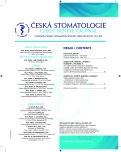-
Medical journals
- Career
Comparison of Dental Study Plaster Cast and it´s 3D Printed Equivalents
Authors: M. Kašparová 1; L. Gráfová 2; P. Dvořák 2; T. Dostálová 1; A. Procházka 2
Authors‘ workplace: Stomatologická klinika dětí a dospělých 2. LF UK a FN Motol, Praha 1; Ústav počítačové a řídicí techniky, Vysoká škola chemicko-technologická, Praha 2
Published in: Česká stomatologie / Praktické zubní lékařství, ročník 114, 2014, 2, s. 35-39
Category: Original Article – Statistical Study
Overview
Introduction:
Plaster casts present golden standard in keeping patients data in 3D. The aim of this work was (1) to compare linear measurements made on traditional plaster casts and 3D printed copies of dental plaster casts, (2) to find new possibilities of reconstruction of digital data, its reliability based on various criteria and (3) to determine whether 3D printed copies obtained using open source system RepRap can replace traditional plaster casts in dental practice.Material and methods:
10 dental plaster casts from the Orthodontic department, Department of stomatology for children and adults, 2nd Faculty of medicine, Charles University Prague, Czech Republic were scanned by inEos Blue scanner and printed on 3D printer RepRap. Linear measurements between selected points on the dental arches of upper and lower jaws on plaster casts and their 3D copies were recorded and statistically analyzed.Results:
Use of 3D printed copies has many advantages over use of traditional plaster casts, mainly mechanical durability and keeping the data in digital form unless needed for example for forensic reasons. The precision and accuracy of the RepRap 3D printed copies of plaster casts were confirmed based on the statistical analysis. Our study proved that 3D printed copies can replace traditional plaster casts and it is possible to use them for detailed analysis.Key words:
3D printing – stomatology – analysis of study plaster cast
Sources
1. Bell, A., Ayoub, A. F., Siebert, P.: Assessment of the accuracy of a three-dimensional imaging system for archiving dental study models. J. Orthod., roč. 30, 2003, č. 3, s. 219–223.
2. Box, G. E. P.: Non-Normality and Tests on Variances. Biometrika, roč. 40, 1953, č. 3–4, s. 318–335.
3. Chapuis, J., Schramm, A., Pappas, I., Hallermann, W., Schwenzer-Zimmerer, K., Langlotz, F., Caversaccio, M.: A new system for computer-aided preoperative planning and intraoperative navigation during corrective jaw surgery. IEEE Transaction on Information Technology in Biomedicine, roč. 11, 2007, č. 3, s. 274–287.
4. Conover, W. J.: Practical nonparametric statistics, 2nd ed. New York, Wiley, 1980.
5. Fleming, P. S., Marinho, V., Johal, A.: Orthodontic measurements on digital study models compared with plaster models: a systematic review. Orthodont. Craniofacial Res., roč. 14, 2011, s. 1–16.
6. Keating, A. P., Knox, J., Bibb, R., Zhurov, A. I.: A comparison of plaster, digital and reconstructed study model accuracy. J Orthodontics, roč. 35, 2008, s. 191–201.
7. Kondo, T., Ong, S. H., Foong, K. W. C.: Tooth segmentation of dental study models using range images. IEEE Transaction on Medical Imaging, roč. 23, 2004, č. 3, s. 350–362.
8. Leifert, F. M., Leifert, M. M., Efstratiadis, S. S., Cangialosi, J. T.: Comparison of space analysis evaluations with digital models and plaster dental casts. Am. J. Orthod. Dentofacial Orthop., roč. 136, 2009, s. 16.e1–16.e4.
9. Lilliefors, H. W.: On the Komogorov-Smirnov test for normality with mean and variance unknown. J. Amer. Statistical Ass., roč. 62, 1967, s. 399–402.
10. Lilliefors, H. W.: On the Komogorov-Smirnov test for the exponential distribution with mean unknown. J. Amer. Statistical Ass., roč. 64, 1969, s. 387–389.
11. Martinez, W. L., Martinez, A. R.: Computational statistics handbook with MATLAB. Londýn, Chapman & Hall/CRC, 2008.
12. McGuinness, N. J., Stephens, C. D.: Storage of orthodontic study models in hospital units in the U. K. Br. J. Orthod., roč. 19, 1992, s. 227–232.
13. Motohashi, N., Kuroda, T.: A 3D computer-aided design system applied to diagnosis and treatment planning in orthodontics and orthognathic surgery. Eur. J. Orthod., roč. 21, 1999, s. 263–274.
14. Quimby, M. L., Vig, K. W., Rashid, R. G., Firestone, A. R.: The accuracy and reliability of measurements made on computer-based digital models. Angle Orthod., roč. 74, 2004, s. 298–303.
15. Santoro, M., Galkin, S., Teredesai, M., Nicolay, O. F., Cangialosi, T. J.: Comparison of measurements made on digital and plaster models. Am. J. Orthod. Dentofacial. Orthop., roč. 124, 2003, s. 101–105.
16. Sohmura, T., Kojima, T., Wakabayashi, K., Takahashi, J.: Use of an ultrahigh-speed laser scanner for constructing threedimensional shapes of dentition and occlusion. J. Prosthet. Dent., roč. 84, 2000, s. 345–352.
17. Tomassetti, J. J., Taloumis, L. J., Denny, J. M., Fischer, J. R.: A comparison of 3 computerized Bolton tooth-size analyses with a commonly used method. Angle Orthod., roč. 71, 2001, s. 351–357.
18. Whetten, L. J., Williamson, C. P., Heo, G., Varnhagen, C., Major, P.: Variations in orthodontic treatement planning decisions of Class II patients between virtual 3-dimensional models and traditional plaster study models. Am. J. Orthod. Dentofacial Orthop., roč. 130, 2006, 485–491.
19. Zilberman, O., Huggare, J. A., Parikakis, K. A.: Evaluation of the validity of tooth size and arch width measurements using conventional and three-dimensional virtual orthodontic models. Angle Orthod., roč. 73, 2003, s. 301–306.
20. Zimmerman, D. W.: A note on interpretation of the paired-samples t Test. J. Educational Behavioral Statistics, roč. 22, č. 3, 1997, s. 349–360.
Labels
Maxillofacial surgery Orthodontics Dental medicine
Article was published inCzech Dental Journal

2014 Issue 2
Most read in this issue- Occlusal Interference – Part Two
- Comparison of Dental Study Plaster Cast and it´s 3D Printed Equivalents
- Long-term Durability of Composite Restoration Margins in Enviroments with Increased Corrosion Risk
- The Incidence of Tooth Agenesis in Pediatric Patients in the Olomouc Region
Login#ADS_BOTTOM_SCRIPTS#Forgotten passwordEnter the email address that you registered with. We will send you instructions on how to set a new password.
- Career

